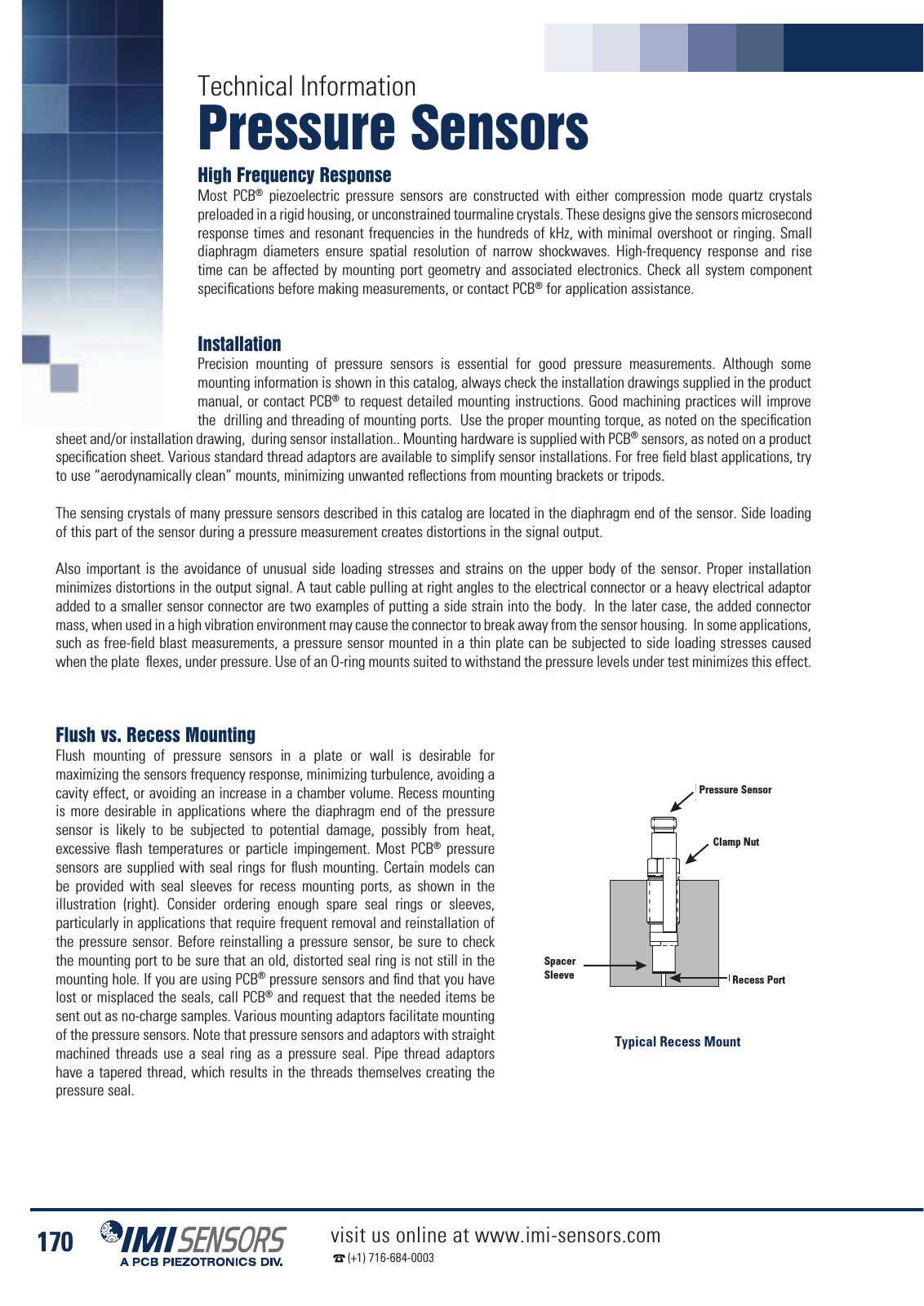IMI Industrial Vibration Sensors Katalog Seite 173
Hinweis: Dies ist eine maschinenlesbare No-Flash Ansicht.Klicken Sie hier um zur Online-Version zu gelangen.
Inhalt
High Frequency Response Most PCB piezoelectric pressure sensors are constructed with either compression mode quartz crystals preloaded in a rigid housing or unconstrained tourmaline crystals These designs give the sensors microsecond response times and resonant frequencies in the hundreds of kHz with minimal overshoot or ringing Small diaphragm diameters ensure spatial resolution of narrow shockwaves High frequency response and rise time can be affected by mounting port geometry and associated electronics Check all system component specifications before making measurements or contact PCB for application assistance Installation Precision mounting of pressure sensors is essential for good pressure measurements Although some mounting information is shown in this catalog always check the installation drawings supplied in the product manual or contact PCB to request detailed mounting instructions Good machining practices will improve the drilling and threading of mounting ports Use the proper mounting torque as noted on the specification sheet and or installation drawing during sensor installation Mounting hardware is supplied with PCB sensors as noted on a product specification sheet Various standard thread adaptors are available to simplify sensor installations For free field blast applications try to use aerodynamically clean mounts minimizing unwanted reflections from mounting brackets or tripods The sensing crystals of many pressure sensors described in this catalog are located in the diaphragm end of the sensor Side loading of this part of the sensor during a pressure measurement creates distortions in the signal output Also important is the avoidance of unusual side loading stresses and strains on the upper body of the sensor Proper installation minimizes distortions in the output signal A taut cable pulling at right angles to the electrical connector or a heavy electrical adaptor added to a smaller sensor connector are two examples of putting a side strain into the body In the later case the added connector mass when used in a high vibration environment may cause the connector to break away from the sensor housing In some applications such as free field blast measurements a pressure sensor mounted in a thin plate can be subjected to side loading stresses caused when the plate flexes under pressure Use of an O ring mounts suited to withstand the pressure levels under test minimizes this effect Flush vs Recess Mounting Flush mounting of pressure sensors in a plate or wall is desirable for maximizing the sensors frequency response minimizing turbulence avoiding a cavity effect or avoiding an increase in a chamber volume Recess mounting is more desirable in applications where the diaphragm end of the pressure sensor is likely to be subjected to potential damage possibly from heat excessive flash temperatures or particle impingement Most PCB pressure sensors are supplied with seal rings for flush mounting Certain models can be provided with seal sleeves for recess mounting ports as shown in the illustration right Consider ordering enough spare seal rings or sleeves particularly in applications that require frequent removal and reinstallation of the pressure sensor Before reinstalling a pressure sensor be sure to check the mounting port to be sure that an old distorted seal ring is not still in the mounting hole If you are using PCB pressure sensors and find that you have lost or misplaced the seals call PCB and request that the needed items be sent out as no charge samples Various mounting adaptors facilitate mounting of the pressure sensors Note that pressure sensors and adaptors with straight machined threads use a seal ring as a pressure seal Pipe thread adaptors have a tapered thread which results in the threads themselves creating the pressure seal Typical Recess Mount Pressure Sensor Clamp Nut Recess Port Spacer Sleeve Technical Information Pressure Sensors 170 visit us online at www imi sensors com 1 716 684 0003
